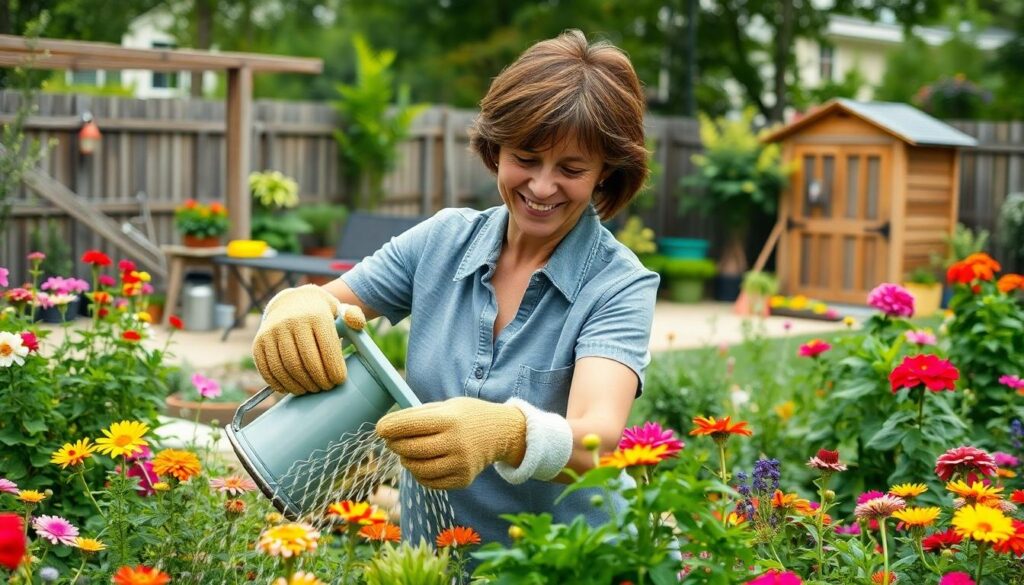Leaving our gardens behind while traveling can be a source of anxiety. We’ve all felt that pang of worry – will our carefully tended plants survive until we return? Whether you’re planning a weekend getaway or an extended vacation, protecting your garden doesn’t have to be complicated.
We’ve gathered the most effective strategies to keep your garden thriving even when you’re miles away. From smart watering answers to enlisting help from neighbors, these practical tips will ensure your botanical paradise remains lush and healthy throughout your absence. Don’t let garden concerns dampen your travel excitement – with proper preparation, you can enjoy your trip knowing your green space is protected.
10 Essential Steps to Keep Your Garden Safe While Traveling
- Install an automatic irrigation system before your departure. These systems deliver precise amounts of water directly to your plants on a programmed schedule, preventing both under and overwatering. Smart irrigation controllers even adjust watering based on weather forecasts, saving water and keeping your garden perfectly hydrated.
- Mulch all garden beds thoroughly to retain moisture and suppress weeds. Apply a 2-3 inch layer of organic mulch such as wood chips, straw, or compost around your plants at least a week before traveling. This simple step significantly reduces water evaporation and keeps soil temperatures more stable.
- Ask a trusted neighbor or friend to check on your garden periodically. Provide them with clear instructions, including which plants need special attention and how to identify potential problems. Offering to reciprocate the favor or bringing back a small gift shows appreciation for their help.
- Move potted plants to shadier locations where they’ll receive less direct sunlight and require less frequent watering. Grouping container plants together creates a beneficial microclimate that helps maintain humidity and reduces water loss through evaporation.
- Harvest ripe produce right before you leave to prevent overripening and attracting pests. Donate extra produce to food banks or neighbors rather than letting it go to waste. Removing mature vegetables also encourages plants to direct energy toward developing new fruits.
- Weed thoroughly throughout your garden beds before departing. Weeds compete with your plants for water and nutrients, so eliminating them gives your garden the best chance to thrive in your absence. Focus especially on removing any flowering weeds that might go to seed.
- Secure loose items and garden structures that could be damaged by wind or storms. This includes staking tall plants, storing lightweight pots and garden ornaments, and ensuring greenhouse doors and windows are properly fastened. Check that fences and gates are in good repair to prevent animal intrusions.
- Apply organic pest deterrents before leaving to protect vulnerable plants. Neem oil spray, diatomaceous earth, or homemade garlic and pepper sprays can keep common pests at bay without harsh chemicals. Target plants that typically attract pests in your garden.
- Create a detailed care guide for anyone watching your garden. Include photos of your plants, exact watering needs, signs of common problems, and your contact information. This visual reference helps even non-gardeners provide effective care during your absence.
- Set up a remote monitoring system for longer trips or particularly valuable gardens. Wi-Fi enabled soil moisture sensors, weather stations, and security cameras allow you to check on your garden from anywhere in the industry. These technologies provide peace of mind and allow you to alert your garden sitter to potential problems.
Prepare Your Plants for Your Absence
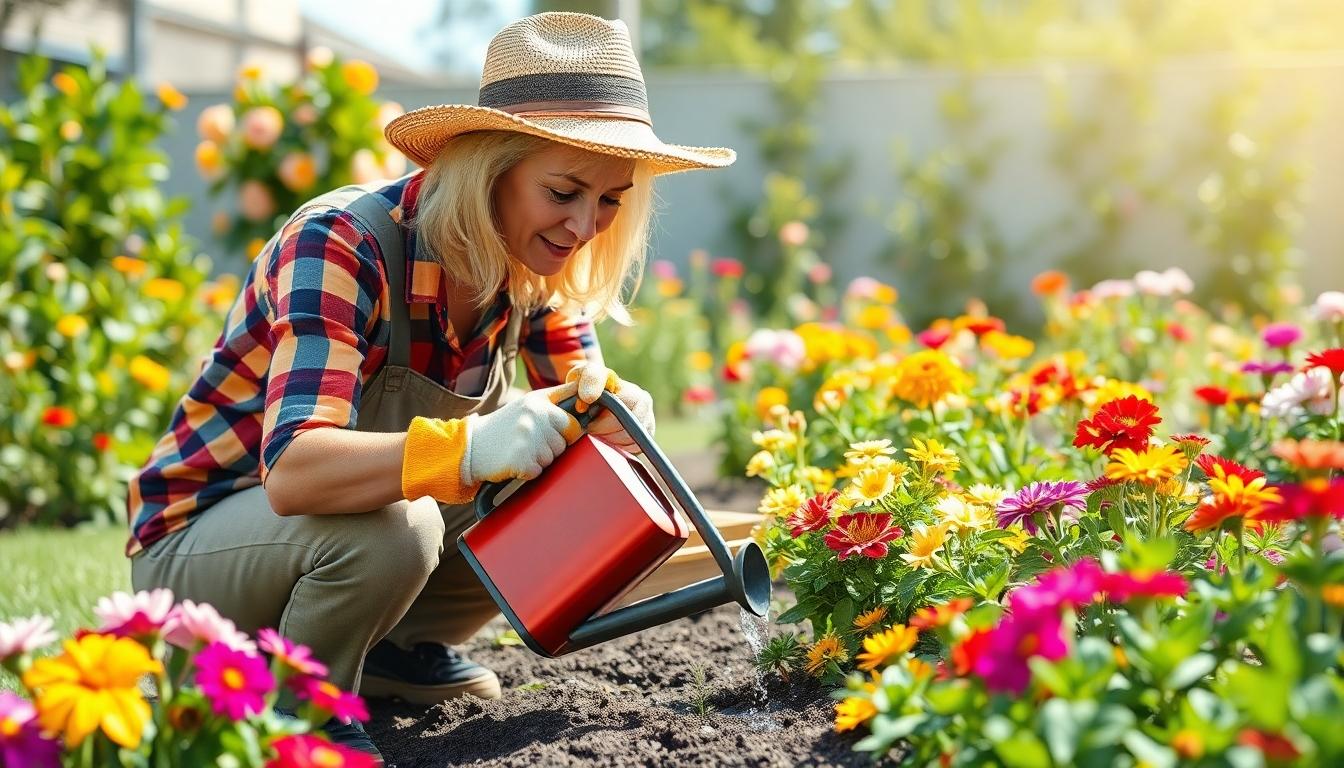
Before you hit the road for your well-deserved vacation, taking time to properly prepare your plants will ensure they thrive during your absence. These essential pre-travel garden preparations can make all the difference between returning to healthy plants or struggling ones.
Thorough Watering Before Departure
Deeply hydrate your soil 1-2 days before leaving to ensure moisture reaches the root systems where it’s needed most. This timing allows water to fully penetrate while avoiding soggy conditions that might promote disease. Adding 2-3 inches of organic mulch such as straw or wood chips significantly slows evaporation and helps maintain soil moisture levels throughout your absence. Remember to direct water at the soil rather than foliage to prevent fungal issues that could develop while you’re away. Your plants will better withstand periods without regular watering when their root zones are thoroughly moistened before your departure.
Strategic Pruning and Deadheading
Remove spent blooms, damaged foliage, and excess growth before traveling to reduce your plants’ water requirements and minimize fungal disease risks. This strategic maintenance decreases the metabolic demands on your plants during your absence. Focus your pruning efforts on high-maintenance specimens like flowering annuals and vegetables that typically require more frequent attention. By prioritizing these resource-intensive plants, you’ll better allocate the limited water and nutrients available during your time away. Proper pruning also improves air circulation around plants, further reducing disease pressure when you’re not around to monitor for early signs of problems.
Set Up an Effective Irrigation System
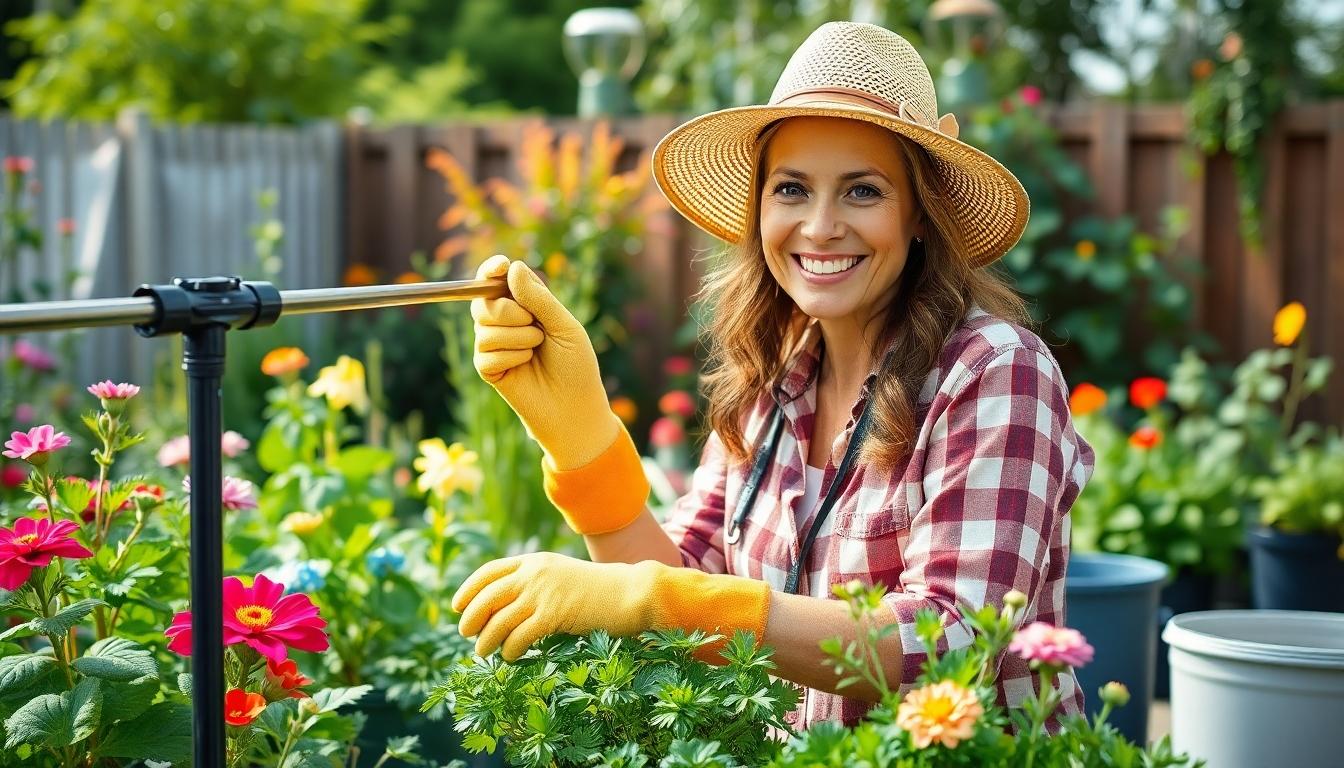
Installing a reliable irrigation system is perhaps the most critical step to ensure your garden thrives during your absence. The right setup will deliver precise amounts of water exactly when your plants need it.
Automatic Timers and Drip Systems
Drip irrigation systems like Gardena Micro-Drip and LetPot Smart Drip provide targeted moisture directly to plant roots, dramatically reducing water waste compared to conventional methods. These systems feature adjustable drippers that can be customized for different plants’ water requirements. Smart irrigation controllers such as the LetPot 2.0 and OtO Lawn enable convenient scheduling through mobile apps, with intelligent weather adjustments and real-time monitoring capabilities. For gardeners seeking flexibility, Snip-n-Drip kits from Gardener’s Supply offer customizable layouts perfectly suited for raised beds, containers, and traditional garden plots.
Programmable timers eliminate the guesswork by maintaining consistent watering cycles during your travels. We recommend setting exact intervals—about 10 minutes daily is appropriate for many gardens—to prevent the common problem of overwatering. Wi-Fi and Bluetooth-enabled devices from brands like LetPot and OtO provide remote control functionality through iOS and Android applications, allowing you to adjust your watering schedule from anywhere in the industry. Always test your system 3-5 days before departure to identify and fix any potential leaks or scheduling errors before you leave.
Self-Watering Containers and Plant Sitters
Self-watering containers with built-in water reservoirs offer a reliable solution for potted plants, which typically require more frequent attention due to their limited soil volume. Advanced systems like LetPot’s perlite-filtered designs reduce clogging issues while maintaining consistent moisture levels throughout your absence. For shorter trips, simple wicking systems using cotton ropes placed in water jars provide passive hydration that keeps plants properly moistened without mechanical components.
Arranging for a plant sitter adds an extra layer of protection for your garden. Share detailed care instructions with neighbors or friends who agree to help, including exact guidance for different plant varieties. Potted plants should be prioritized for daily checks since they deplete soil moisture more rapidly than in-ground plantings. Vegetable beds benefit most from deep, infrequent watering sessions that encourage strong root development rather than frequent shallow watering. Provide your plant sitter with emergency contact information and clear guidelines about which plants need the most attention, ensuring they understand the critical difference between maintaining containers versus garden beds.
Protect Against Pests and Wildlife
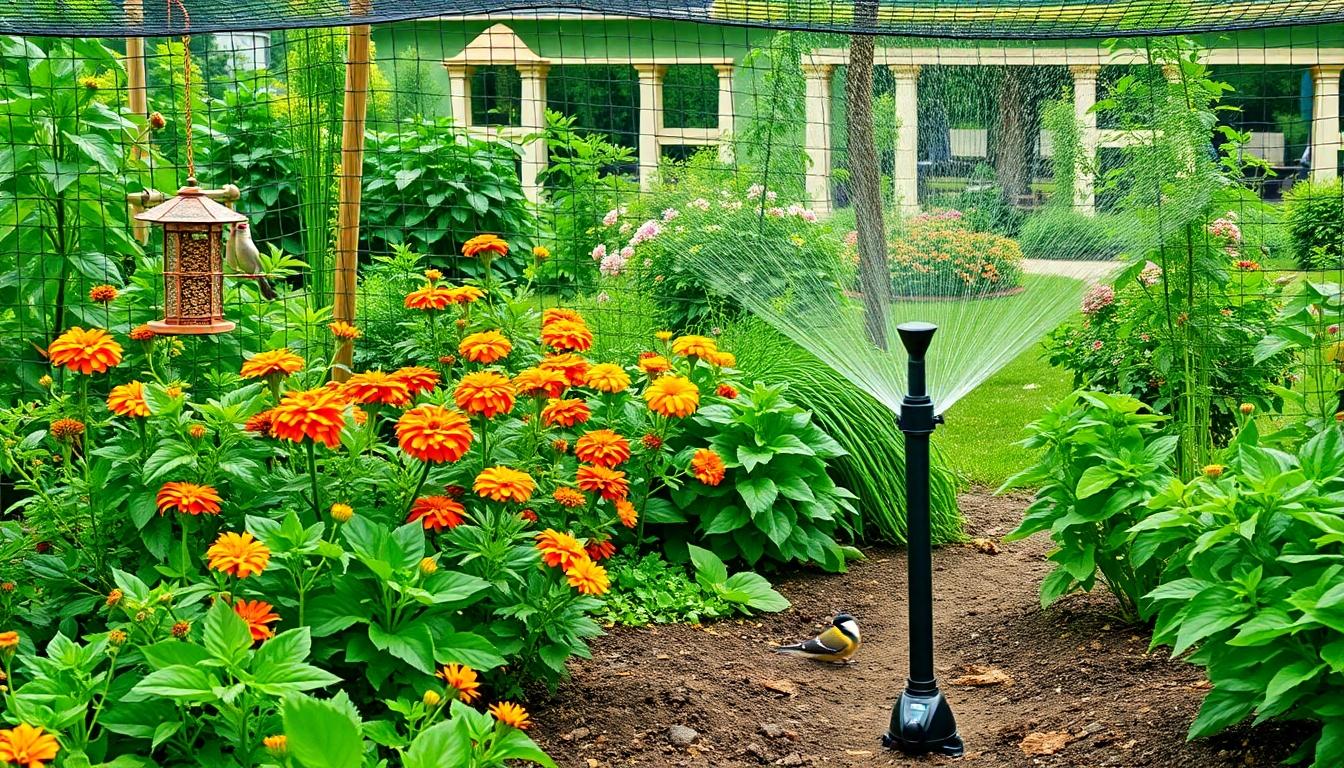
While you’re away enjoying your vacation, your garden becomes an open buffet for pests and wildlife. Implementing effective protection strategies before departure will keep unwanted visitors at bay and your plants safe.
Natural Barriers and Deterrents
Natural deterrents offer an eco-friendly way to protect your garden without harsh chemicals. Apply organic repellents like garlic or chili pepper sprays directly to plants before leaving to create an invisible barrier against common pests. We recommend planting companion species strategically throughout your garden beds—marigolds and basil naturally repel insects through their strong scents and volatile compounds. Attracting beneficial predators can also help maintain the natural balance in your garden network. Consider installing bird feeders or planting insectary plants that invite natural pest controllers like ladybugs and praying mantises to patrol your garden during your absence.
Protective Netting and Fencing
Physical barriers provide immediate protection against larger wildlife that might damage your garden. Install bird netting over fruit-bearing plants and trees to prevent birds from enjoying your harvest before you return from vacation. Wire mesh fencing buried 6-12 inches deep around vulnerable garden areas effectively blocks burrowing animals like rabbits and groundhogs from accessing your plants. For smaller garden beds or individual plants needing extra protection, cloches or row covers create a protective shield against rodents and insects while still allowing sunlight and water to reach your plants. These physical defenses require minimal maintenance during your absence and provide reliable protection.
Preemptive Measures
Taking preventative action before your departure significantly reduces pest problems. Remove all decaying plant matter and weeds from your garden beds to eliminate potential pest habitats and breeding grounds. Apply a generous layer of mulch around plants to suppress weed growth and maintain soil moisture levels, reducing plant stress that typically attracts opportunistic pests. Secure your compost bins with tight-fitting lids or latches to prevent scavengers from turning them into all-you-can-eat buffets. These simple steps create a less inviting environment for garden pests while you’re away.
Automated Answers
Technology offers hands-free protection for your garden during travel. Motion-activated sprinklers startle and deter larger animals like deer and raccoons without requiring your presence. Ultrasonic devices emit high-frequency sounds uncomfortable to many mammals but inaudible to humans, keeping unwanted visitors at a distance. Yellow sticky traps placed strategically throughout your garden catch flying insects before they can damage plants. Pheromone lures attract and trap exact pest species, reducing their populations without requiring daily maintenance. These automated answers continue working throughout your absence, ensuring your garden remains protected until your return.
Enlist Help from Neighbors or Garden Services
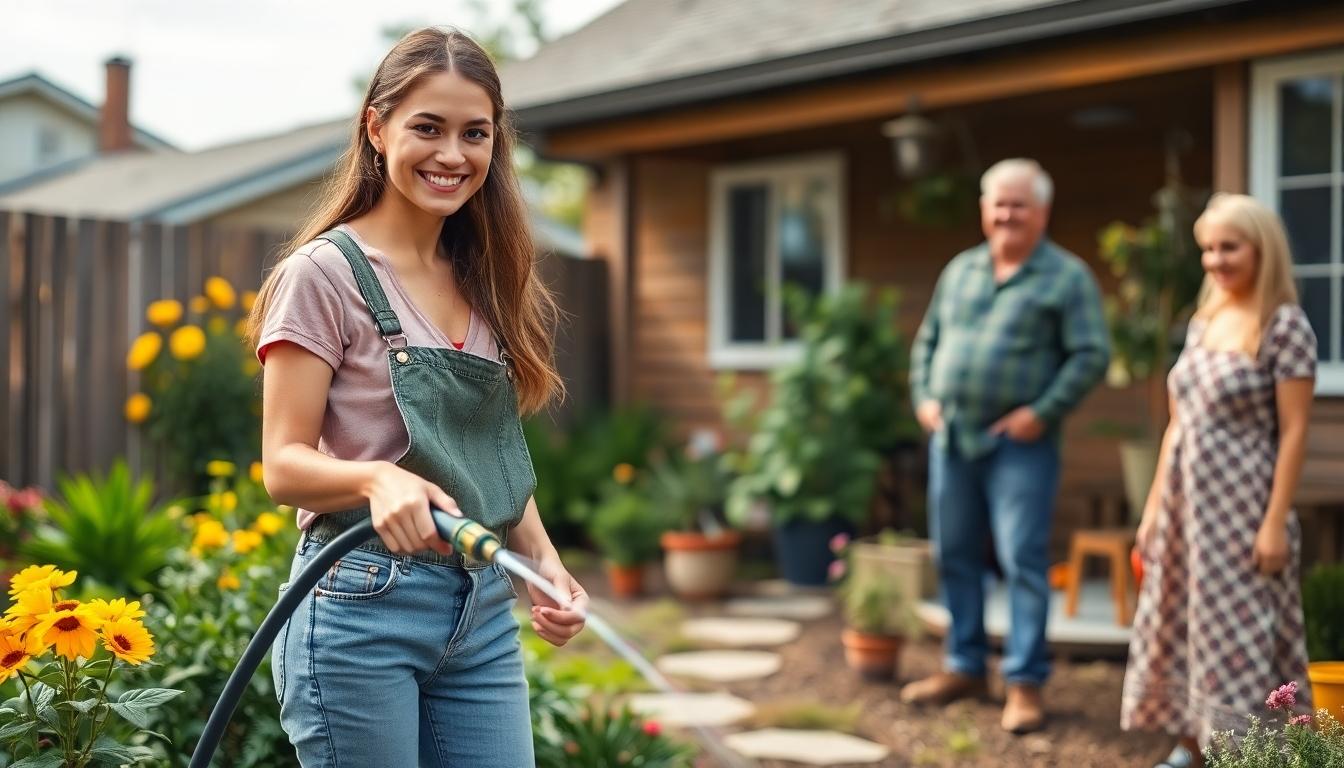
When you’re away from home, having someone physically check on your garden provides peace of mind that automated systems alone can’t deliver. Human oversight ensures your plants receive appropriate care even though changing weather conditions or potential system malfunctions.
Creating Clear Care Instructions
Written guidelines are essential for anyone tending to your garden while you’re away. Start by creating detailed watering schedules that specify exactly how often each area needs attention, emphasizing deep watering at the root zone for maximum effectiveness. Include plant-exact information highlighting which varieties are moisture-sensitive and which can tolerate drier conditions. Don’t forget to add harvesting timelines listing which vegetables or fruits will likely ripen during your absence to prevent overripening and food waste. Provide troubleshooting steps for common issues such as wilting plants, pest appearances, or unexpected weather changes so your helper can respond appropriately without needing to contact you repeatedly. Clear, thorough instructions empower your garden helper to make informed decisions that keep your plants thriving while you’re traveling.
Offering Incentives for Garden Helpers
Motivating helpers ensures your garden receives consistent attention during your absence. Consider offering reciprocal services such as collecting their mail or watching their pets when they travel as a fair exchange for garden care. Sharing your harvest makes for an appealing incentive, allowing helpers to enjoy fresh produce as a reward for their efforts. Financial compensation works well for more extensive care requirements, particularly for longer trips or gardens that need specialized attention. Professional services require clear payment terms and scope discussions before your departure, specifying exactly which tasks are included and how much they’ll cost. Recognition of your helper’s time and effort through thoughtful incentives cultivates goodwill and increases the likelihood they’ll provide attentive care to your precious plants.
Use Mulch to Conserve Soil Moisture
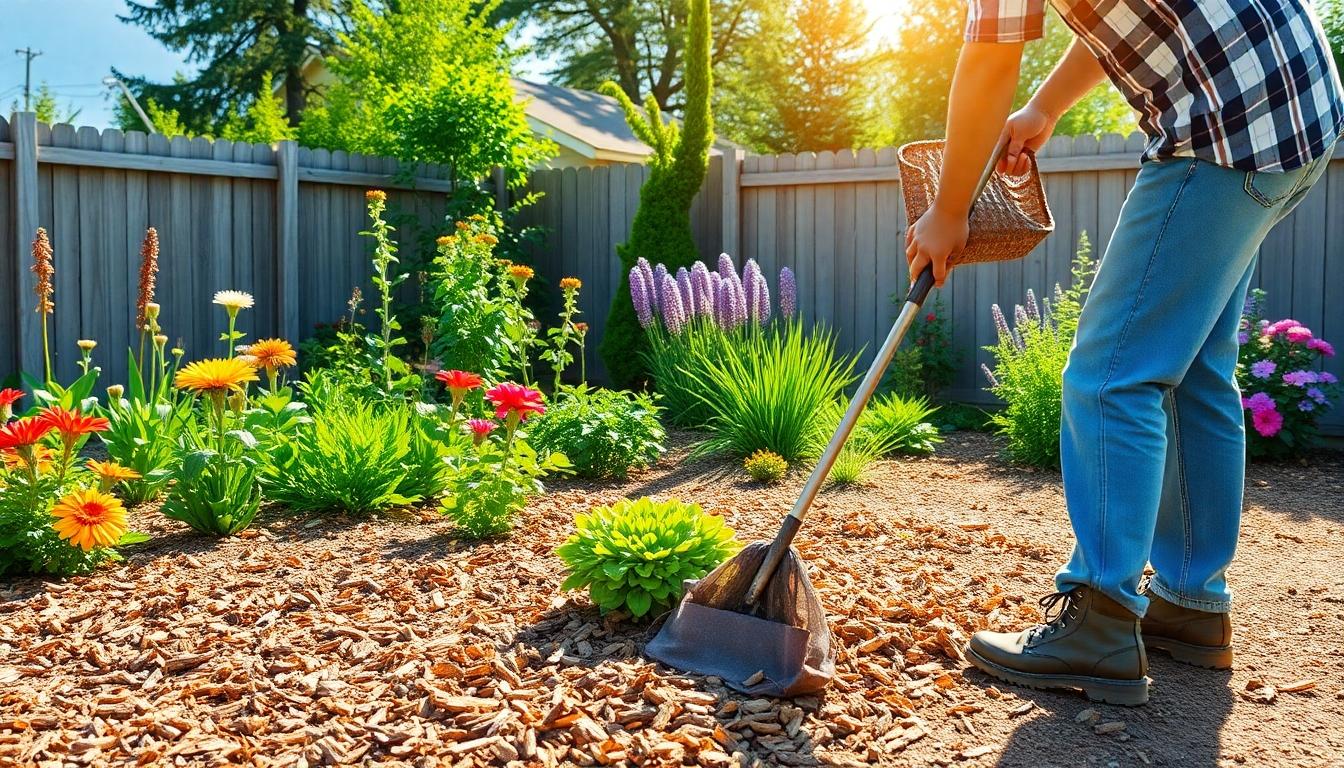
Mulching is one of the most effective strategies for maintaining garden health during your absence. This simple technique creates a protective barrier that conserves soil moisture, suppresses weed growth, and shields plants from temperature fluctuations—making it essential for travelers who want to return to a thriving garden.
Organic Mulch Options
Several excellent organic mulch materials can keep your garden healthy while you’re away:
- Wood Chips provide superior moisture retention and effectively reduce soil temperature during hot weather, making them ideal for summer travel.
- Straw offers excellent weed suppression capabilities while gradually breaking down to enrich your soil with valuable nutrients.
- Bark Mulch protects against soil erosion during unexpected rain showers and helps maintain proper soil structure throughout your absence.
- Leaves work wonderfully as a free mulch option that improves soil composition while decomposing to feed your plants with essential nutrients.
Proper Mulch Application Techniques
Follow these key techniques for effective mulching before your trip:
- Depth: Apply mulch in a layer up to 3 inches thick for optimal moisture conservation without suffocating plant roots or stems.
- Timing: Always mulch immediately after thoroughly watering your garden to trap maximum moisture in the soil profile.
- Spread Evenly: Distribute mulch uniformly around plants while maintaining a few inches of clearance around plant stems and trunks to prevent rot issues.
For best results, we recommend watering deeply before applying mulch, as this creates a reservoir of moisture that your plants can access during your absence. Remember to remove any existing weeds before mulching to prevent them from competing with your plants for water and nutrients while you’re away. Consider implementing an automatic irrigation system with timers for consistent moisture levels, especially for extended trips.
Move Potted Plants to Shaded Areas
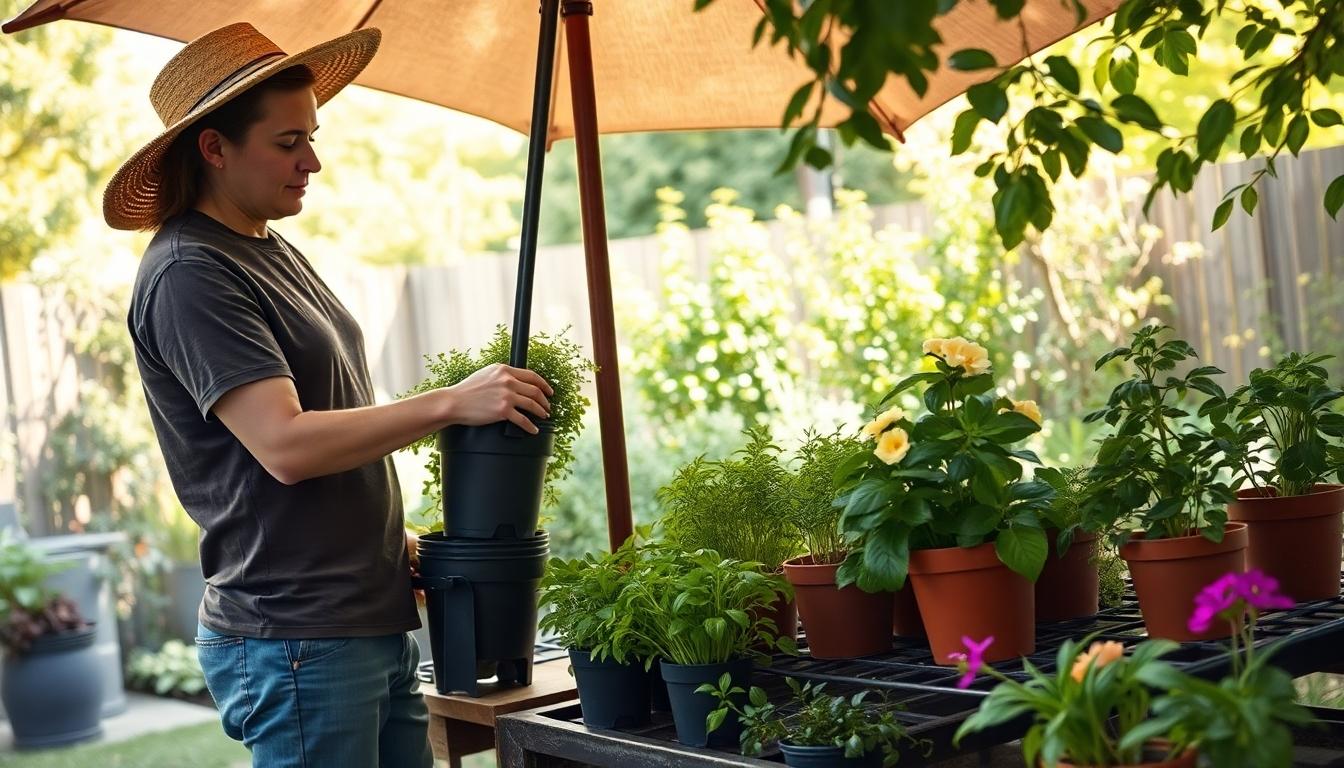
When traveling, one of the most effective ways to protect your potted plants is by relocating them to shadier spots. Potted plants are particularly vulnerable to direct sunlight, especially those typically kept indoors, as they can suffer from irreversible leaf scorching when exposed to intense light for extended periods. To safeguard your container garden while you’re away, place these plants in full-shade or part-shade locations depending on their exact light requirements.
Grouping Plants for Humidity
Creating a microclimate for your plants can significantly improve their chances of thriving during your absence. By clustering potted plants together, you’ll harness the natural process of transpiration where plants release moisture into the surrounding air. This grouping technique effectively increases the humidity levels around your plants, reducing water loss and stress while you’re traveling. Plants positioned in groups maintain moisture longer than those left isolated, making this an ideal strategy for extended trips. The collective humidity also helps protect the outer plants in the group from drying winds and extreme temperature fluctuations.
Creating Temporary Shade Structures
Not all gardens have naturally shaded areas available, so constructing temporary shade answers becomes essential for plant protection during travel. Sunshades or umbrellas offer quick and effective coverage for potted plants, shielding them from harsh midday sun when UV radiation is most intense. Shade cloths present another versatile option, as they can be draped over simple frames or existing structures to create protected areas with filtered light that won’t completely deprive plants of the sunlight they need. Cardboard or paper covers serve as budget-friendly alternatives for short trips, providing adequate protection during peak sun hours while allowing enough light through during cooler parts of the day. Remember to check your local weather forecast before leaving to determine which shade structure will best protect your garden from the anticipated conditions during your time away.
Install Security Measures for Valuable Plants
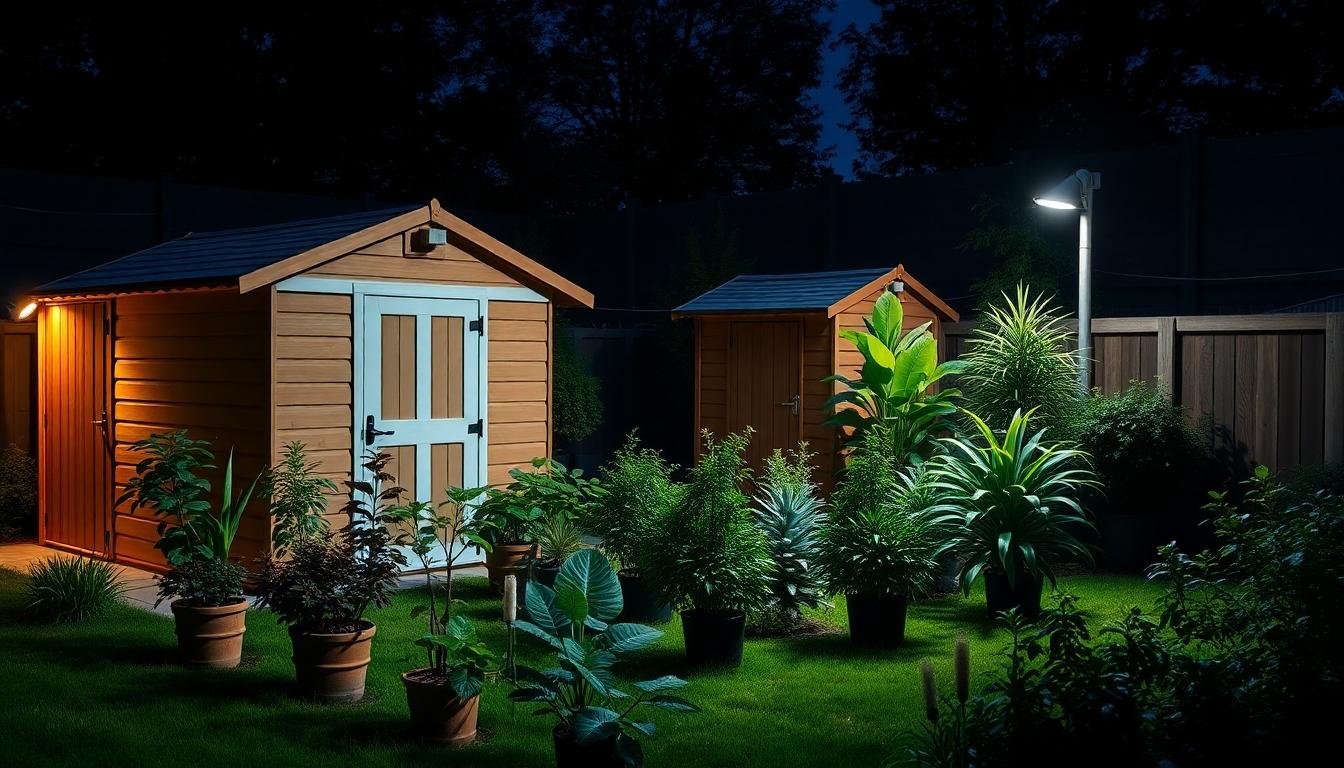
Protecting your garden’s valuable plants and equipment is essential when you’re away from home. Implementing proper security measures not only deters theft but also provides peace of mind during your travels.
Secure Valuable Garden Items
Weatherproof padlocks and chains serve as excellent deterrents for securing garden sheds, gates, and expensive tools. Bolt down any costly equipment to make theft more difficult and time-consuming for potential intruders. High-value plants deserve special attention—consider placing fencing around your most precious specimens to prevent them from being targeted. For bicycles or larger equipment stored in your garden area, use heavy-duty locks paired with wall or ground anchors to create a formidable security system.
Motion-Activated Lighting
Motion-activated lights provide an effective first line of defense against nighttime trespassers. Install these security lights at key entry points around your garden, particularly near gates, pathways, and areas where valuable plants or equipment are located. The sudden illumination startles potential intruders and draws attention to unauthorized activity on your property. Strategic placement of these lights creates the impression that someone is home and responding to movement, significantly reducing the likelihood of theft or vandalism during your absence.
Garden Monitoring Cameras
Weather-resistant monitoring cameras offer comprehensive surveillance of your garden while you’re away. Modern systems feature motion-sensing technology that alerts you via smartphone when movement is detected in your garden. Remote access capabilities allow you to check on your plants and property in real-time from anywhere in the industry. Position cameras to cover entry points, valuable plant collections, and any equipment storage areas for maximum effectiveness. These visual monitoring systems complement physical security measures and provide valuable evidence in the unlikely event of a security breach.
Additional Security Precautions
Always secure loose items like furniture, decorative elements, and smaller tools before departing. Remove any objects that could potentially become improvised tools for breaking into storage areas. The combination of physical deterrents (locks, fences), electronic security (lights, cameras), and proper garden maintenance (pruning, mulching) creates multiple layers of protection. Designating a trusted caretaker adds human oversight to your security plan, as regular visits to your property signal occupancy and allow for prompt response to any issues that arise.
Harvest Ripe Produce Before Leaving
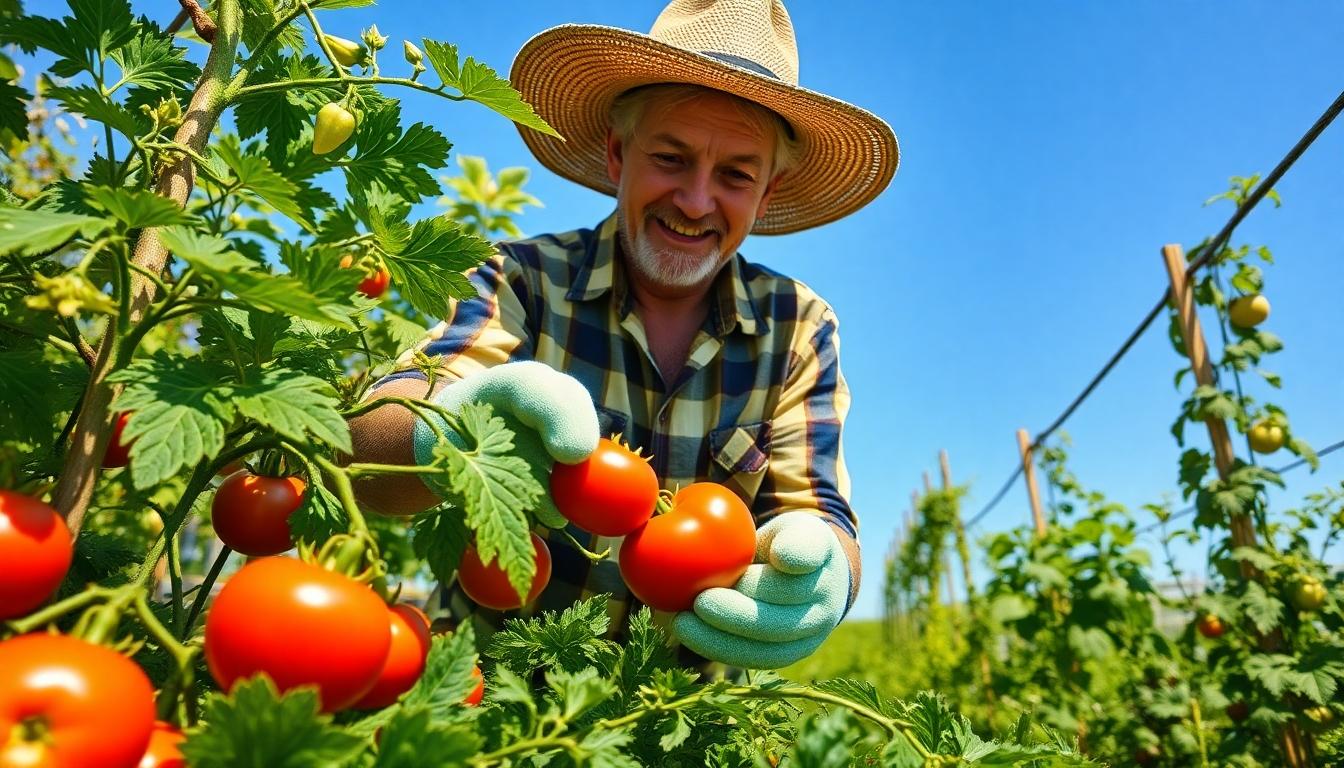
Harvesting ripe produce before your trip is essential for maintaining healthy plants and preventing waste. Taking time to collect mature fruits and vegetables prevents overripening and spoilage, which can attract pests and lead to plant diseases during your absence.
Preserving or Sharing Your Harvest
Don’t let your hard-earned produce go to waste while you’re away. Freezing vegetables and fruits is an excellent preservation method that locks in nutrients and flavor for future enjoyment. Canning and dehydrating offer additional options to extend the shelf life of your garden bounty, allowing you to savor your harvest long after your trip ends.
Consider sharing your excess produce with neighbors or friends if preservation isn’t feasible. This generous gesture not only prevents waste but also creates an opportunity to ask for garden assistance during your absence. Many neighbors will gladly water your plants or check on your garden in exchange for fresh, homegrown produce.
Preventing Overripe Fruit Issues
Remove all ripe and overripe fruits from your plants before departing to significantly reduce pest attraction and disease risks. Overripe produce left on plants can quickly decay, creating perfect conditions for fungal diseases that might spread throughout your garden. Fallen fruit can also attract unwanted visitors like rodents and insects that might damage other healthy plants.
Set up support structures for plants expected to produce while you’re away. Stakes, trellises, and cages provide crucial support for tomatoes, cucumbers, pole beans, and other climbing vegetables that will continue growing during your absence. These supports prevent stems from breaking under the weight of new growth and keep developing fruits off the ground where they might rot or become susceptible to pests.
Weather-Proof Your Garden Space

When traveling, proper weather-proofing can safeguard your garden against unexpected conditions. Taking preventative measures ensures your plants remain healthy and your garden structures stay intact during your absence.
Mulching
Mulching serves as a powerful defense against weather fluctuations while you’re away. Apply an extra layer of mulch around your plants to retain essential soil moisture and prevent weed competition. This protective barrier acts as insulation, regulating soil temperature during hot or cold spells. Organic mulches like wood chips, straw, or compost gradually break down to feed your soil, offering dual benefits during your absence. For optimal results, apply mulch 2-3 inches deep, keeping it slightly away from plant stems to prevent rot issues.
Watering Systems
Installing automated watering systems provides reliable hydration for your garden while traveling. Drip irrigation delivers precise amounts of water directly to plant roots, minimizing waste and preventing leaf diseases. Programmable timers allow customization based on your garden’s exact needs and local weather patterns. Smart controllers with moisture sensors can adjust watering schedules in response to rainfall, ensuring plants receive optimal moisture without your supervision. Setting up these systems before departure guarantees consistent care that manual watering by neighbors can’t always provide.
Securing Loose Items and Structures
Garden furniture and decorations can become hazards during strong winds or storms while you’re away. Move lightweight items like chairs, cushions, and planters to a secure indoor location such as a shed or garage. For heavier furniture that can’t be relocated, chain pieces together and lock them to prevent movement or theft. Solar lights, wind chimes, and decorative stakes should be collected and stored safely to prevent damage or loss. Ensure garden tools are properly cleaned and locked away in secure storage areas to protect them from weather damage and potential theft.
Preparing for Seasonal Weather Events
Strategic pruning before traveling helps minimize weather-related garden damages. Trim trees and shrubs to remove dead or weak branches that could break during storms, while simultaneously eliminating potential hiding spots for intruders. Arrange for lawn care maintenance through a service or neighbor to keep grass at an appropriate height, particularly important during rainy seasons when growth accelerates. Setting up temporary shade structures for sensitive plants provides protection against unexpected heat waves. Consider installing rain barrels with overflow systems to capture precipitation without flooding your garden beds during heavy downpours.
By implementing these weather-proofing strategies, we’ll help ensure your garden not only survives but thrives during your absence, regardless of what Mother Nature has planned.
Conduct a Final Garden Check Before Departure
Preparing your garden before travel doesn’t have to be overwhelming. With the right systems in place—from automatic irrigation to enlisting helpful neighbors—you can enjoy your trip without constant worry about your plants.
Remember that a little preparation goes a long way. Deep watering followed by mulching creates a foundation for success while securing loose items and harvesting ripe produce prevents potential problems before they start.
We’ve shared proven strategies to keep your garden thriving in your absence whether you’re away for a weekend or several weeks. By implementing these protective measures you’ll return to find your garden just as beautiful as when you left—perhaps even with new harvests waiting for you!
Your garden can thrive even when you’re not there to tend it daily. Safe travels and happy gardening!
Frequently Asked Questions
How do I water my garden while on vacation?
Install an automatic irrigation system with a programmable timer for precise watering. Drip irrigation is ideal as it delivers water directly to plant roots. For potted plants, consider self-watering containers or wicking systems. Deep water your garden 1-2 days before leaving and apply a thick layer of mulch to retain moisture. For longer trips, asking a neighbor to check on your watering system provides extra assurance.
Should I hire a plant sitter when I travel?
Yes, having a plant sitter can be extremely valuable, especially for longer trips. Choose someone reliable and provide them with detailed instructions about each plant’s needs. Create a simple care guide that includes watering schedules, which plants need special attention, and when to harvest ripe produce. Offering incentives like sharing your harvest or reciprocal services can motivate your helper to provide consistent care.
How can I protect my garden from pests while away?
Apply organic pest deterrents before departure and implement physical barriers like bird netting or wire mesh fencing for larger animals. Remove decaying plant matter and secure compost bins to create a less inviting environment. Consider installing motion-activated sprinklers or ultrasonic devices for hands-free protection. Companion planting can also naturally deter certain pests and maintain ecological balance in your absence.
What should I do with my potted plants when traveling?
Move potted plants to shadier locations to reduce water loss through evaporation. Group containers together to create a more humid microclimate. Consider using self-watering containers or wicking systems for consistent moisture. For longer trips, sink smaller pots directly into garden beds where they’ll retain moisture better. You can also create temporary shade structures for additional protection during hot weather.
Should I harvest my vegetables before leaving?
Yes, harvest all ripe produce before departing to prevent overripening and spoilage, which can attract pests and diseases. For produce that’s close to ripening, consider harvesting slightly early. Preserve excess harvest by freezing, canning, or dehydrating, or share with neighbors (especially those helping with garden care). Remove all overripe fruits and vegetables from plants and garden beds to reduce pest attraction.
How can I prepare my garden for unexpected weather while away?
Apply an extra layer of mulch to regulate soil temperature and retain moisture. Secure loose items and structures that could become hazards during storms. Install rain shutoffs on irrigation systems to prevent overwatering during rainy periods. For hot weather, set up temporary shade cloths for sensitive plants. In storm-prone seasons, prune weak branches before leaving and ensure proper drainage systems are functioning.
What’s the best mulch to use before traveling?
Organic mulches like straw, wood chips, or shredded leaves are ideal before travel as they break down slowly and improve soil health. Apply a 2-3 inch layer around plants, keeping it a few inches away from stems to prevent rot. Newspaper or cardboard covered with organic material provides excellent weed suppression for longer trips. Avoid fresh grass clippings which can mat down and create water-repellent barriers.
How can I secure my valuable plants and garden equipment?
Store expensive tools and equipment in locked sheds or garages. Consider using weatherproof padlocks and cable locks for larger items that cannot be stored indoors. For particularly valuable plants, either move them out of sight or secure large containers with ground anchors. Installing motion-activated lights or simple surveillance cameras can deter theft. Inform trusted neighbors about your absence so they can alert you to suspicious activity.
Is it better to move plants indoors when I travel?
For short trips, most garden plants should remain outdoors with proper care arrangements. However, valuable or sensitive potted plants may benefit from being moved indoors where temperature and humidity are more controlled. Place these plants away from direct sunlight and heating/cooling vents. For houseplants already indoors, group them together in a bathroom with natural light or place them on water-filled trays with pebbles for humidity.
How far in advance should I prepare my garden before traveling?
Begin preparing your garden at least a week before departure. Start by deep cleaning, weeding, and pruning 5-7 days ahead. Apply pest deterrents 3-4 days before leaving. Set up and test irrigation systems 2-3 days in advance to ensure proper functioning. Perform deep watering 1-2 days prior to departure, followed by mulching. Harvest ripe produce and move potted plants to appropriate locations the day before you leave.

